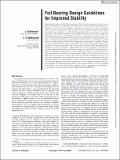Foil Bearing Design Guidelines for Improved Stability
Author(s)
Schiffmann, J.; Spakovszky, Z. S.
DownloadPublished version (3.062Mb)
Terms of use
Metadata
Show full item recordAbstract
Experimental evidence in the literature suggests that foil bearing-supported rotors can suffer from subsynchronous vibration. While dry friction between top foil and bump foil is thought to provide structural damping, subsynchronous vibration is still an unresolved issue. The current paper aims to shed new light onto this matter and discusses the impact of various design variables on stable foil bearing-supported rotor operation. It is shown that, while a time domain integration of the equations of motion of the rotor coupled with the Reynolds equation for the fluid film is necessary to quantify the evolution of the rotor orbit, the underlying mechanism and the onset speed of instability can be predicted by coupling a reduced order foil bearing model with a rigid-body, linear, rotordynamic model. A sensitivity analysis suggests that structural damping has limited effect on stability. Further, it is shown that the location of the axial feed line of the top foil significantly influences the bearing load capacity and stability. The analysis indicates that the static fluid film pressure distribution governs rotordynamic stability. Therefore, selective shimming is introduced to tailor the unperturbed pressure distribution for improved stability. The required pattern is found via multiobjective optimization using the foil bearing-supported rotor model. A critical mass parameter is introduced as a measure for stability, and a criterion for whirl instability onset is proposed. It is shown that, with an optimally shimmed foil bearing, the critical mass parameter can be improved by more than two orders of magnitude. The optimum shim patterns are summarized for a variety of foil bearing geometries with different L/D ratios and different degrees of foil compliance in a first attempt to establish more general guidelines for stable foil bearing design. At low compressibility (λ < 2), the optimum shim patterns vary little with bearing geometry; thus, a generalized shim pattern is proposed for low compressibility numbers.
Date issued
2012-12Department
Massachusetts Institute of Technology. Gas Turbine LaboratoryJournal
Journal of Tribology
Publisher
American Society of Mechanical Engineers (ASME)
Citation
Schiffman, J. et al. "Foil Bearing Design Guidelines for Improved Stability." Journal of Tribology 135, 1 (December 2012): 011103 © 2013 ASME
Version: Final published version
ISSN
0742-4787
1528-8897